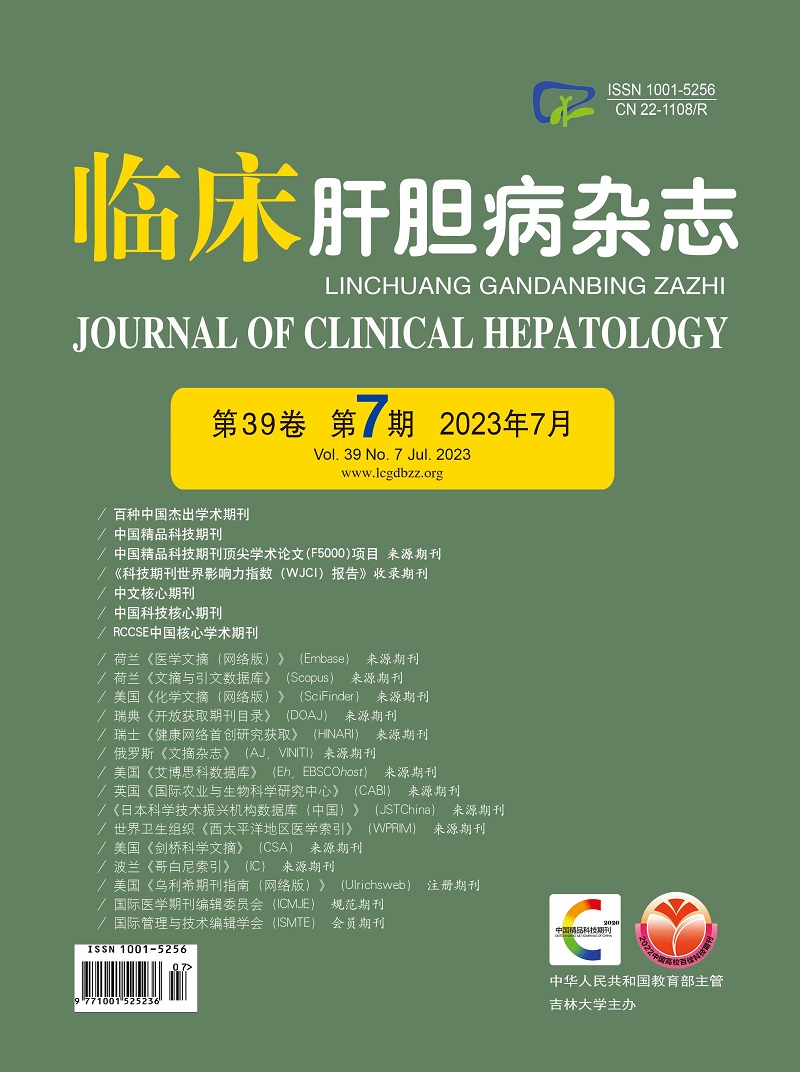| [1] |
SUNG H, FERLAY J, SIEGEL RL, et al. Global Cancer Statistics 2020: GLOBOCAN estimates of incidence and mortality worldwide for 36 cancers in 185 countries[J]. CA Cancer J Clin, 2021, 71(3): 209-249. DOI: 10.3322/caac.21660. |
| [2] |
BRAY F, FERLAY J, SOERJOMATARAM I, et al. Global cancer statistics 2018: GLOBOCAN estimates of incidence and mortality worldwide for 36 cancers in 185 countries[J]. CA Cancer J Clin, 2018, 68(6): 394-424. DOI: 10.3322/caac.21492. |
| [3] |
Chinese Society of Clinical Oncology. Guidelines for diagnosis and treatment of primary liver cancer (2022 edition)[M]. Beijing: People's Medical Publishing House, 2022.
中国临床肿瘤学会. 原发性肝癌诊疗指南(2022年版)[M]. 北京: 人民卫生出版社, 2022.
|
| [4] |
NCCN. NCCN Clinical Practice Guidelines in Oncology (NCCN GuidelinesⓇ)[EB/OL]. Hepatobiliary Cancers. Version 1.2022. https://www.nccn.org/.
|
| [5] |
RAOUL JL, FORNER A, BOLONDI L, et al. Updated use of TACE for hepatocellular carcinoma treatment: How and when to use it based on clinical evidence[J]. Cancer Treat Rev, 2019, 72: 28-36. DOI: 10.1016/j.ctrv.2018.11.002. |
| [6] |
LO CM, NGAN H, TSO WK, et al. Randomized controlled trial of transarterial lipiodol chemoembolization for unresectable hepatocellular carcinoma[J]. Hepatology, 2002, 35(5): 1164-1171. DOI: 10.1053/jhep.2002.33156. |
| [7] |
LLOVET JM, REAL MI, MONTAÑA X, et al. Arterial embolisation or chemoembolisation versus symptomatic treatment in patients with unresectable hepatocellular carcinoma: a randomised controlled trial[J]. Lancet, 2002, 359(9319): 1734-1739. DOI: 10.1016/S0140-6736(02)08649-X. |
| [8] |
ARAMAKI O, TAKAYAMA T, MORIGUCHI M, et al. Arterial chemoembolisation with cisplatin versus epirubicin for hepatocellular carcinoma (ACE 500 study): A multicentre, randomised controlled phase 2/3 trial[J]. Eur J Cancer, 2021, 157: 373-382. DOI: 10.1016/j.ejca.2021.08.027. |
| [9] |
IKEDA M, KUDO M, AIKATA H, et al. Transarterial chemoembolization with miriplatin vs. epirubicin for unresectable hepatocellular carcinoma: a phase Ⅲ randomized trial[J]. J Gastroenterol, 2018, 53(2): 281-290. DOI: 10.1007/s00535-017-1374-6. |
| [10] |
Chinese College of Interventionalists, Chinese Medical Doctor Association. Chinese clinical practice guidelines for transarterial chemoembolization of hepatocellular carcinoma[J]. Chin J Intern Med, 2021, 60(7): 599-614. DOI: 10.3760/cma.j.cn112137-20210425-00991. |
| [11] |
FU J, WANG Y, ZHANG J, et al. The safety and efficacy of transarterial chemoembolisation with bleomycin for hepatocellular carcinoma unresponsive to doxorubicin: a prospective single-centre study[J]. Clin Radiol, 2021, 76(11): 864. e7-864. e12. DOI: 10.1016/j.crad.2021.07.013. |
| [12] |
WANG Y, FU JX, ZHANG JL, et al. Transarterial chemoembolization with bleomycin treatment for moderate-advenced hepatocellular carcinoma[J]. Nat Med J China, 2018, 98(39): 3166-3170. DOI: 10.3760/cma.j.issn.0376-2491.2018.39.008. |
| [13] |
BESSAR AA, FARAG A, ABDEL MONEM SM, et al. Transarterial chemoembolisation in patients with hepatocellular carcinoma: low-dose doxorubicin reduces post-embolisation syndrome without affecting survival-prospective interventional study[J]. Eur Radiol Exp, 2021, 5(1): 10. DOI: 10.1186/s41747-021-00204-6. |
| [14] |
ZHANG Z, WU Y, ZHENG T, et al. Efficacy of transarterial chemoembolization combined with molecular targeted agents for unresectable hepatocellular carcinoma: A network meta-analysis[J]. Cancers (Basel), 2022, 14(15). DOI: 10.3390/cancers14153710. |
| [15] |
SCHICHO A, HELLERBRAND C, KRÜGER K, et al. Impact of different embolic agents for transarterial chemoembolization (TACE) procedures on systemic vascular endothelial growth factor (VEGF) levels[J]. J Clin Transl Hepatol, 2016, 4(4): 288-292. DOI: 10.14218/JCTH.2016.00058. |
| [16] |
SERGIO A, CRISTOFORI C, CARDIN R, et al. Transcatheter arterial chemoembolization (TACE) in hepatocellular carcinoma (HCC): the role of angiogenesis and invasiveness[J]. Am J Gastroenterol, 2008, 103(4): 914-921. DOI: 10.1111/j.1572-0241.2007.01712.x. |
| [17] |
KUDO M, UESHIMA K, IKEDA M, et al. Randomised, multicentre prospective trial of transarterial chemoembolisation (TACE) plus sorafenib as compared with TACE alone in patients with hepatocellular carcinoma: TACTICS trial[J]. Gut, 2020, 69(8): 1492-1501. DOI: 10.1136/gutjnl-2019-318934. |
| [18] |
LEE TY, LIN CC, CHEN CY, et al. Combination of transcatheter arterial chemoembolization and interrupted dosing sorafenib improves patient survival in early-intermediate stage hepatocellular carcinoma: A post hoc analysis of the START trial[J]. Medicine (Baltimore), 2017, 96(37): e7655. DOI: 10.1097/MD.0000000000007655. |
| [19] |
XU X, MENG Q. Drug effect analysis of sorafenib combined with transcatheter arterial chemoembolization in the treatment of advanced hepatocellular carcinoma[J]. Pak J Pharm Sci, 2018, 31(4(Special)): 1751-1755.
|
| [20] |
CAI R, SONG R, PANG P, et al. Transcatheter arterial chemoembolization plus sorafenib versus transcatheter arterial chemoembolization alone to treat advanced hepatocellular carcinoma: a meta-analysis[J]. BMC Cancer, 2017, 17(1): 714. DOI: 10.1186/s12885-017-3707-5. |
| [21] |
DING X, SUN W, LI W, et al. Transarterial chemoembolization plus lenvatinib versus transarterial chemoembolization plus sorafenib as first-line treatment for hepatocellular carcinoma with portal vein tumor thrombus: A prospective randomized study[J]. Cancer, 2021, 127(20): 3782-3793. DOI: 10.1002/cncr.33677. |
| [22] |
LU W, JIN XL, YANG C, et al. Comparison of efficacy between TACE combined with apatinib and TACE alone in the treatment of intermediate and advanced hepatocellular carcinoma: A single-center randomized controlled trial[J]. Cancer Biol Ther, 2017, 18(6): 433-438. DOI: 10.1080/15384047.2017.1323589. |
| [23] |
ZHAO S, ZHANG T, DOU W, et al. A comparison of transcatheter arterial chemoembolization used with and without apatinib for intermediate- to advanced-stage hepatocellular carcinoma: a systematic review and meta-analysis[J]. Ann Transl Med, 2020, 8(8): 542. DOI: 10.21037/atm.2020.02.125. |
| [24] |
CAO Y, SUN T, GUO X, et al. Sorafenib versus apatinib both combined transarterial chemoembolization for hepatocellular carcinoma with portal vein tumor thrombosis: A comparative retrospective study[J]. Front Oncol, 2021, 11: 673378. DOI: 10.3389/fonc.2021.673378. |
| [25] |
QIU Z, SHEN L, JIANG Y, et al. Transarterial chemoembolization (TACE) combined with apatinib versus TACE combined with sorafenib in advanced hepatocellular carcinoma patients: a multicenter retrospective study[J]. Ann Transl Med, 2021, 9(4): 283. DOI: 10.21037/atm-20-5360. |
| [26] |
GUO W, CHEN S, WU Z, et al. Efficacy and safety of transarterial chemoembolization combined with anlotinib for unresectable hepatocellular carcinoma: A retrospective study[J]. Technol Cancer Res Treat, 2020, 19: 1533033820965587. DOI: 10.1177/1533033820965587. |
| [27] |
TURPIN A, de BAERE T, HEURGUÉ A, et al. Liver transarterial chemoembolization and sunitinib for unresectable hepatocellular carcinoma: Results of the PRODIGE 16 study[J]. Clin Res Hepatol Gastroenterol, 2021, 45(2): 101464. DOI: 10.1016/j.clinre.2020.05.012. |
| [28] |
XU Q, HUANG Y, SHI H, et al. Sunitinib versus sorafenib plus transarterial chemoembolization for inoperable hepatocellular carcinoma patients[J]. J BUON, 2018, 23(1): 193-199.
|
| [29] |
CHAN SL, YEO W, MO F, et al. A phase 2 study of the efficacy and biomarker on the combination of transarterial chemoembolization and axitinib in the treatment of inoperable hepatocellular carcinoma[J]. Cancer, 2017, 123(20): 3977-3985. DOI: 10.1002/cncr.30825. |
| [30] |
ZHANG S, ZHAO Y, HE L, et al. Effect of camrelizumab plus transarterial chemoembolization on massive hepatocellular carcinoma[J]. Clin Res Hepatol Gastroenterol, 2022, 46(4): 101851. DOI: 10.1016/j.clinre.2021.101851. |
| [31] |
YU SL, LIU DH, WANG C, et al. TACE combined with camrelizumab for treatment of advanced hepatocellular carcinoma[J]. Chin J Interv Imaging Ther, 2022, 19(7): 391-395. DOI: 10.13929/j.issn.1672-8475.2022.07.003. |
| [32] |
MOU L, TIAN X, ZHOU B, et al. Improving outcomes of tyrosine kinase inhibitors in hepatocellular carcinoma: New data and ongoing trials[J]. Front Oncol, 2021, 11: 752725. DOI: 10.3389/fonc.2021.752725. |
| [33] |
ZHANG X, ZHU X, LIU C, et al. The safety and efficacy of transarterial chemoembolization (TACE) + lenvatinib + programmed cell death protein 1 (PD-1) antibody of advanced unresectable hepatocellular carcinoma[J]. J Clin Oncol, 2022, 40(4_suppl): 453-453. DOI: 10.1200/JCO.2022.40.4_suppl.453 |
| [34] |
LI W, PEI Y, WANG Z, et al. Efficacy of transarterial chemoembolization monotherapy or combination conversion therapy in unresectable hepatocellular carcinoma: A systematic review and meta-analysis[J]. Front Oncol, 2022, 12: 930868. DOI: 10.3389/fonc.2022.930868. |
| [35] |
LLOVET JM, VOGEL A, MADOFF DC, et al. Randomized phase 3 LEAP-012 study: Transarterial chemoembolization with or without lenvatinib plus pembrolizumab for intermediate-stage hepatocellular carcinoma not amenable to curative treatment[J]. Cardiovasc Intervent Radiol, 2022, 45(4): 405-412. DOI: 10.1007/s00270-021-03031-9. |
| [36] |
WANG K, YU HM, XIANG YJ, et al. Transcatheter arterial chemoembolization plus atezolizumab and bevacizumab for unresectable hepatocellular carcinoma: a single-arm, phase Ⅱ trial[J]. Future Oncol, 2022, 18(30): 3367-3375. DOI: 10.2217/fon-2022-0188. |









 本站查看
本站查看




 DownLoad:
DownLoad: